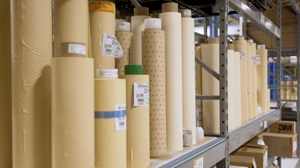If you’re looking for custom masking tape, which type of material should you choose?
It may surprise you that masking tape isn’t only used for painting walls but is actually a commonly used production tool. Masking tape can be used to protect automotive surfaces, plating processes, and a number of other essential painting and coating applications.
Certain manufacturing processes require specialty masking tapes, and as a flexible material converter, Strouse has designed custom masking solutions made from a range of different materials.
Today, we’re going to review masking materials and how you might use them to fulfill your project needs.
WHAT IS ADHESIVE MASKING USED FOR?
Adhesive masking tape covers specific areas to protect them from being painted or coated. People use masking tape in the following applications:
- Fine line masking: used for more detail-oriented and intricate curves or straight lines.
- Powder coating: a surface coating method in which a dry powder is applied electrostatically and cured with heat or UV light.
- Plasma spray: a high-temperature application coating that protects surfaces from corrosion/wear and thermally insulates them.
- Electroplating: uses electricity to cover a surface in metal.
- Sandblasting: smoothing a hard surface or stripping it of paint using particles.
—as well as other scenarios that necessitate a protective covering.
What are the Different Types of Custom Masking Tape?
Different materials will maximize your results in the adhesive masking use cases mentioned above. For instance, foil tape works excellently in high-heat applications, whereas paper tape might catch fire.
Custom masking tape is intended for a specific purpose and has been cut accordingly to function for its intended purpose.
As we cover these masking tapes, you’ll be able to think through your product and its application and whether it necessitates a specific type of material or similar characteristics.
1. GENERAL MASKING TAPE
As you’ve probably guessed, general masking tape is the most well-known type, often used in everyday life for painting.
General masking tapes use natural rubber adhesives to achieve a relatively strong adhesive bond to hold them in place. This type of tape can be used for labeling, bundling, and masking tough surfaces. However, they aren’t designed for clean removal, so they risk leaving residue after an extended application period.
2. PAPER MASKING TAPE
Paper masking or “painter’s tape” functions best in wall painting or decorative uses. Its adhesive is weaker than general masking tape, allowing longer use without sticky residue.
Different types of paper masking tape include flatback, crepe, and tissue tape. It is often converted into fine-line masking tape for pinstriping or other thin designs.
3. HIGH TEMP MASKING TAPE
Objects exposed to heat during painting or coating may require high-temperature masking tape to endure the process. For instance, you might use high-temp masking tape during powder or plasma spray coating and electroplating.
Materials used in high-temp masking tape include but are not limited to:
- Foil tape: resistant to temperatures from -22°F to 302°F (-30°C to 150°C) foil can reflect substantial amounts of heat, allowing the adhesive to survive high-temperature processes, and can often also withstand high pressure.
- PVC Film: this can withstand up to or over 300°F (149°C) making it ideal for high-temperature use cases for industrial applications.
- Polyester/PET tape: resists temperatures up to 425°F (218°C) and is commonly used in powder coating, electroplating, anodizing, and high-temperature splicing.
- Polyimide/Kapton tape: typically used in temperatures ranging from -103°F to 500°F (-75°C to 260°C) but it has been proven to withstand temperatures as high as 752°F (400°C).
In addition, many of these high-temp masking tapes are generally durable and reinforced against tearing.
4. ABRASIVE-RESISTANT MASKING TAPE
Processes such as sandblasting, impact stripping, and dry media blast paint removal are intended to cause abrasion, but not every surface is the intended target.
Abrasive-resistant masking tape helps protect specific areas, such as windows or openings, from damage. These tapes are commonly used on vehicles.
By absorbing a significant portion of the energy from abrasive processes, anti-abrasion materials prevent the tape from being blasted away by aluminum oxide, glass or plastic beads, etc. Some of the abrasive-resistant masking materials include polyurethane, PET, and vinyl. These tapes can be used as stencils for sandblasting on glass, wood, and other materials.
Finding Custom Masking Tape
Now that you’ve read about the different types of masking tape, it’s time to decide which suits your project.
As you can see, finding suitable tape will depend on the nature of your project and factors such as how powerful your adhesive must be and whether it needs to withstand heat, pressure, or abrasion. There’s also the matter of printability and planned method of production.
Without the right experience, navigating the material selection process risks being stressful and filled with issues.
Each type of custom masking tape is only a category with many different materials and suppliers. With so many materials to choose from, it’s a challenge to figure out where to even begin from
Converters can help you refine your project from a simple idea into a fully-fledged manufacturing process.
If you’re interested in seeking custom masking tape for your project, contact a converter or check out our Learning Center for more masking resources.








